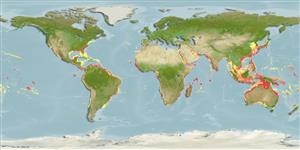>
Tetraodontiformes (Puffers and filefishes) >
Monacanthidae (Filefishes)
Etymology: Aluterus: Name from Greek meaning not free or detached, referring to the pelvis that does not form a spiny project (as it does in triggerfish) (R. Chandler, pers. Comm. 10/2014).
More on author: Linnaeus.
Environment: milieu / climate zone / depth range / distribution range
Ekologi
laut berasosiasi dengan karang; kisaran kedalaman 1 - 80 m (Ref. 90102). Subtropical; 43°N - 39°S, 180°W - 180°E
Circumtropical. Western Atlantic: Massachusetts, USA to Argentina (Ref. 36453). Eastern Atlantic: west coast of tropical Africa (Ref. 3592). Eastern Pacific: Guatemala to Chile (Ref. 9068); probably in Mexico (Ref. 9318). Western Indian Ocean: Mozambique and South Africa (Ref. 4421). Recently recorded from Reunion (Ref. 53568).
Size / Weight / umur
Maturity: Lm ? range ? - ? cm
Max length : 76.2 cm TL jantan/; (Ref. 26340); common length : 40.0 cm TL jantan/; (Ref. 3467); Berat maksimum terpublikasi: 2.7 kg (Ref. 40637)
Duri punggung (Keseluruhan (total)) : 2; duri punggung lunak (Keseluruhan (total)) : 45 - 52; Duri dubur: 0; Sirip dubur lunak: 47 - 53. Rudimentary pelvic spine disappears in large specimen (Ref. 36453). Snout convex in adults (Ref. 1602). Sandy to grey with small brown spots above; soft dorsal and anal fins pale yellowish to brownish; caudal membrane blackish brown (Ref. 4421).
Occasionally in shallow water by steep drop-offs. Solitary or in pairs, occasionally in groups of five or six, at less than 10 m depth. Juveniles are pelagic, seen under floating objects (Ref. 9318, 48637). Benthopelagic (Ref. 58302). Adults and juveniles are rarely seen near reefs. Juveniles often with large jellies and these may bring them close to reefs and adults may nest on sandflats adjacent to reefs in deep water. At other times, the adults may form large schools under weed-rafts that usually form during the wet season (Ref. 48637). Feed on benthic organisms (Ref. 30573).
Life cycle and mating behavior
Kematangan | Reproduksi, perkembang biakan | Pemijahan | telur-telur | Fecundity | Larva
Distinct pairing (Ref. 205).
Harmelin-Vivien, M.L. and J.-C. Quéro, 1990. Monacanthidae. p. 1061-1066. In J.C. Quero, J.C. Hureau, C. Karrer, A. Post and L. Saldanha (eds.) Check-list of the fishes of the eastern tropical Atlantic (CLOFETA). JNICT, Lisbon; SEI, Paris; and UNESCO, Paris. Vol. 2. (Ref. 3592)
Status IUCN Red List (Ref. 130435: Version 2024-2)
ancaman kepada manusia
Reports of ciguatera poisoning (Ref. 30911)
penggunaan manusia
Perikanan: komersial; Ikan buruan: ya
Alat, peralatan
laporan khas
muat turun XML
Sumber internet
Estimates based on models
Preferred temperature (Ref.
123201): 22.8 - 29, mean 27.6 °C (based on 1868 cells).
Phylogenetic diversity index (Ref.
82804): PD
50 = 0.5625 [Uniqueness, from 0.5 = low to 2.0 = high].
Bayesian length-weight: a=0.01905 (0.01192 - 0.03047), b=2.89 (2.75 - 3.03), in cm total length, based on LWR estimates for this species & (Sub)family-body (Ref.
93245).
Trophic level (Ref.
69278): 3.8 ±0.0 se; based on diet studies.
Generation time: 5.0 ( na - na) years. Estimated as median ln(3)/K based on 1
growth studies.
Daya lenting (Ref.
120179): sedang, Waktu penggandaan populasi minimum 1.4 - 4.4 tahun (Preliminary K or Fecundity.).
Fishing Vulnerability (Ref.
59153): Moderate to high vulnerability (48 of 100).
Nutrients (Ref.
124155): Calcium = 13.9 [5.6, 53.9] mg/100g; Iron = 0.487 [0.214, 1.238] mg/100g; Protein = 19.3 [17.1, 21.4] %; Omega3 = 0.154 [0.071, 0.304] g/100g; Selenium = 21.9 [8.3, 50.9] μg/100g; VitaminA = 23.4 [6.0, 98.0] μg/100g; Zinc = 0.522 [0.321, 0.882] mg/100g (wet weight);
